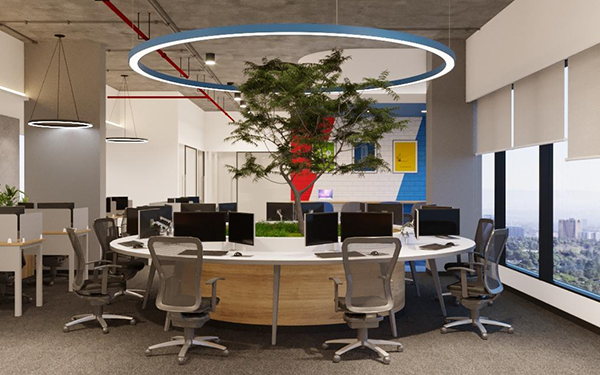
Modern office design trends have been evolving rapidly over the past few years, driven by a variety of factors such as technology advancements, employee preferences, and changing work cultures. Some of the latest trends in modern office design include:
This trend has been gaining popularity in recent years, with offices increasingly opting for open plan layouts that allow for greater flexibility and collaboration. Flexibility is also being promoted by introducing movable walls, furniture and dividers which can be easily reconfigured to accommodate different needs.
Biophilic design seeks to integrate nature into office spaces, incorporating natural elements such as plants, water features, and natural materials to create a more calming and relaxing environment. It can improve air quality, increase productivity and reduce stress levels.
With technology playing a significant role in modern work environments, office designs are now incorporating elements such as wireless charging stations, touchless interfaces, smart lighting, and voice-activated controls.
Employee wellness is a growing concern, and ergonomic design aims to create a comfortable, healthy, and safe work environment. The use of ergonomic furniture, adjustable desks, and chairs can help to reduce the risk of musculoskeletal disorders and boost employee productivity.
The need for collaboration and teamwork in modern workplaces is being reflected in office design. Spaces such as huddle rooms, breakout areas, and meeting pods are being created to facilitate communication and teamwork.
Overall, modern office design is moving towards creating more functional, comfortable, and stimulating spaces that promote employee well-being, foster collaboration and creativity while reflecting a company's values and brand identity.
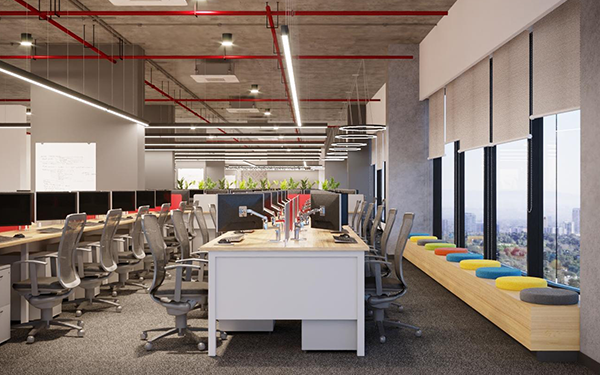
Modern office design can boost productivity in several ways. Here are some points to consider while selecting a modern office design:
Offices with ample natural light have been shown to improve productivity and employee well-being. Large windows, skylights, and glass walls can be incorporated to allow more natural light into the workspace.
The design of the office furniture and layout can impact employee health and productivity. Ergonomic chairs, adjustable desks, and standing workstations can all help improve posture and reduce discomfort.
Modern office design often features open spaces to encourage collaboration, communication, and teamwork. This can lead to increased productivity as employees feel more engaged and connected to their colleagues.
Colors can have a significant impact on our moods and emotions. Careful selection of colors in the office design can promote creativity, focus, and energy.
The use of technology in the workplace is essential to modern office design. Incorporating the latest technology into the office space can enhance productivity and make tasks easier and more efficient.
Overall, modern office design plays a crucial role in enhancing productivity in the workplace. By incorporating natural lighting, ergonomic furniture, open spaces, color psychology, and technology integration, employers can create a more productive and engaging work environment.
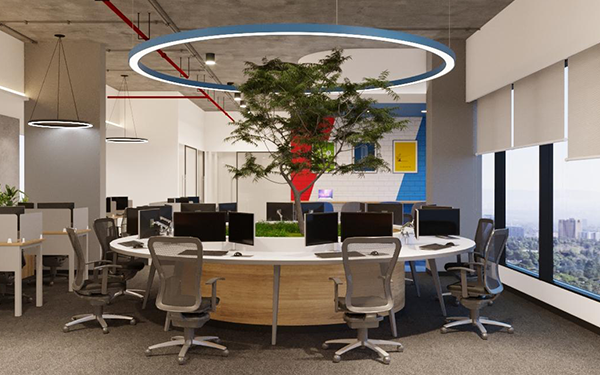
When it comes to modern office design, there are several mistakes that should be avoided to ensure a productive and pleasant workspace for employees. Here are some common mistakes to avoid in modern office designs:
It's important to prioritize the comfort and health of employees by choosing ergonomic furniture and equipment in modern office designs.
Natural light has been shown to boost productivity and mood, so ensure that your modern office design has ample access to natural light.
Good air quality is crucial for employee health and productivity, so make sure your modern office designs has adequate ventilation and air filtration systems.
Overcrowding can make employees feel cramped and uncomfortable, leading to decreased productivity and job satisfaction. Make sure your modern office design isn’t overcrowded.
Noise pollution can be a major distraction in the workplace, so consider sound-absorbing materials and design elements in modern office designs to reduce noise levels.
By avoiding these common mistakes, you can create a modern office design that is functional, comfortable, and conducive to productivity and employee well-being.
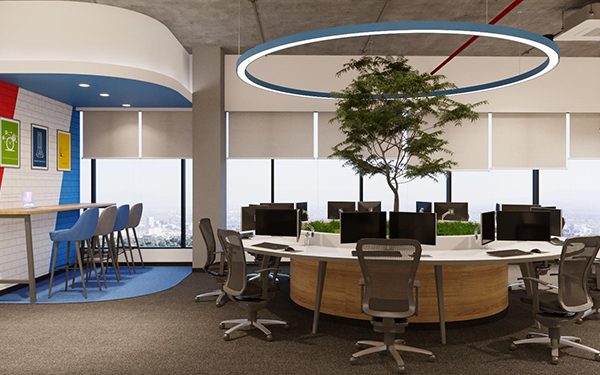
A modern office design should prioritize functionality, comfort, and aesthetic appeal. Some key elements to consider include:
An open floor plan in modern office design can facilitate collaboration and communication among team members. It also creates a sense of spaciousness in modern office design, which can improve the overall mood and productivity of employees.
Natural lighting in modern office design is essential for creating a comfortable and healthy work environment. It has been shown to reduce eye strain, headaches, and fatigue, while also boosting productivity and mood.
Ergonomic chairs, desks, and other furniture are used in modern office design to promote good posture and reduce the risk of repetitive strain injuries. They also help employees stay comfortable and focused throughout the day.
Modern office designs need to accommodate the latest technology, including computers, laptops, smartphones, and other devices. Design elements such as wireless charging stations, smartboards, and video conferencing equipment in modern office designs can make the workplace more efficient and connected.
Eco-friendly design features, such as energy-efficient lighting, green materials, and sustainable landscaping in modern office designs can reduce the environmental impact of the office while also improving the health and well-being of employees.
By incorporating these key elements into your modern office design, you can create a functional and comfortable workplace that meets the needs of your employees and promotes productivity and success.
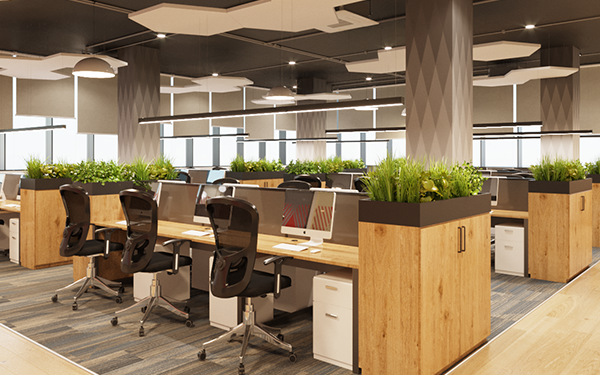
A modern office design should prioritize functionality, comfort, and aesthetic appeal. Some key elements to consider include:
Lighting is an essential aspect of modern office design, and it plays a crucial role in the productivity, health, and well-being of employees. Good lighting can improve concentration, reduce eyestrain and headaches, and enhance mood, while poor lighting can lead to fatigue, eyestrain, and headaches. Hence it is important to consider lighting aspects in modern office designs.
Lighting in modern office designs is often used to create a comfortable and productive work environment. It is important to strike a balance between natural and artificial light, as natural light provides many health benefits, including regulating the body's circadian rhythm, reducing stress, and boosting mood.
Lighting should also be designed to accommodate different tasks and workstations in the office. For example, task lighting is essential for areas in modern office designs where employees need to read or work on detailed tasks, while ambient lighting is important for creating a comfortable and relaxing atmosphere.
Additionally, energy-efficient lighting solutions are becoming increasingly popular in modern office design, as they can help reduce energy costs and contribute to a more sustainable workplace. Therefore, it is important to consider lighting as an essential element in modern office design to promote a healthy, productive, and sustainable work environment.
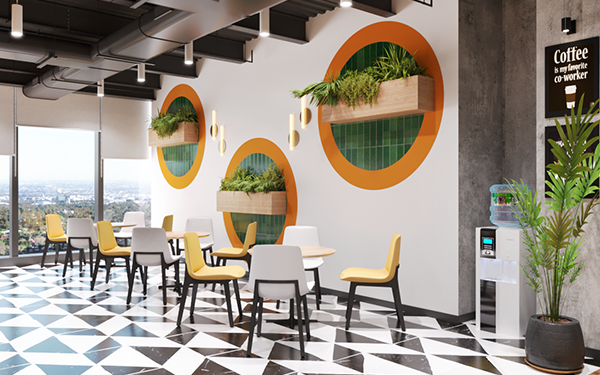
Modern office design can have a significant impact on employee well-being. Here are a few ways that modern office design can impact employee well-being:
Access to natural light is essential for employee well-being. Natural light has been linked to improved mood, better sleep, and higher productivity. Modern office design should prioritize natural light by maximizing windows and creating open spaces that allow natural light to penetrate deep into the office.
Poor office design can lead to physical discomfort and even injury. Modern office design should prioritize ergonomics by providing adjustable furniture, ergonomic keyboards and mice, and standing desks.
Excessive noise can lead to stress and decreased productivity. Modern office design should prioritize noise reduction by incorporating sound-absorbing materials, noise-cancelling headphones, and private meeting rooms.
Modern office design should also prioritize collaborative spaces that allow employees to work together and collaborate on projects. These spaces should be designed to encourage creativity, communication, and teamwork.
Biophilic design involves incorporating natural elements such as plants, water features, and natural materials into the office design. This can help reduce stress, improve mood, and enhance overall well-being.
By prioritizing natural light, ergonomics, noise reduction, collaborative spaces, and biophilic design, modern office design can have a positive impact on employee well-being, leading to increased productivity, better job satisfaction, and lower rates of absenteeism and turnover.
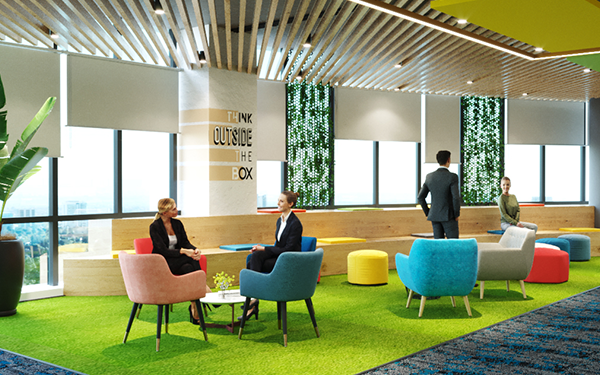
Modern office design often emphasizes clean lines, minimalism, and a focus on functionality. When it comes to color schemes, there are several popular options that can help create a professional and inviting environment in a modern office design. Here are some of the most popular color schemes for a modern office design:
Using neutral colors such as white, gray, and beige as a base in modern office design can help create a calming and professional atmosphere in the office. These colors also pair well with bolder accent colors.
A monochromatic color scheme in modern office design involves using different shades of a single color. This can create a cohesive and sophisticated look in the office.
Incorporating bold accent colors in modern office design, such as vibrant blues or greens, can add energy and creativity to a workspace. These colors can be used on walls, furniture, or accessories throughout the modern office design.
Using natural colors such as browns, greens, and blues in modern office design can create a calming and organic feel in the office. These colors can be incorporated through the use of natural materials such as wood or plants.
Overall, the best color scheme for a modern office design will depend on the specific goals and needs of the business. It's important to consider factors such as brand identity, employee productivity, and the overall vibe of the workspace when choosing a color scheme for modern office design.
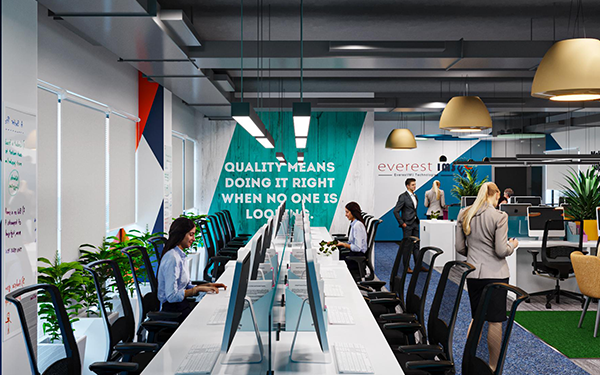
Technology can be effectively incorporated into modern office design in several ways, including:
One way to incorporate technology into modern office design is by integrating technology into furniture. For example, desks can be designed with built-in charging ports, and chairs can be equipped with sensors that adjust the height and tilt based on the user's posture.
Modern offices often require collaboration and teamwork. By installing collaborative technology such as interactive whiteboards, video conferencing tools, and cloud-based collaboration software in modern office designs, employees can work together seamlessly, regardless of their location.
Another way to incorporate technology into modern office design is by creating smart offices. This can be achieved by installing sensors that can monitor things like temperature, lighting, and air quality, and adjust them accordingly in modern office designs. Smart offices can also utilize the Internet of Things (IoT) to automate routine tasks and improve productivity.
Many companies are now embracing remote work, and technology can be used to support this trend. Providing remote working facilities such as video conferencing tools, cloud-based software, and VPNs in modern office designs, can help employees work from anywhere, increasing their productivity and work-life balance.
By incorporating technology into modern office design, companies can create modern, flexible, and efficient workspaces that meet the needs of their employees and enable them to work smarter, not harder.
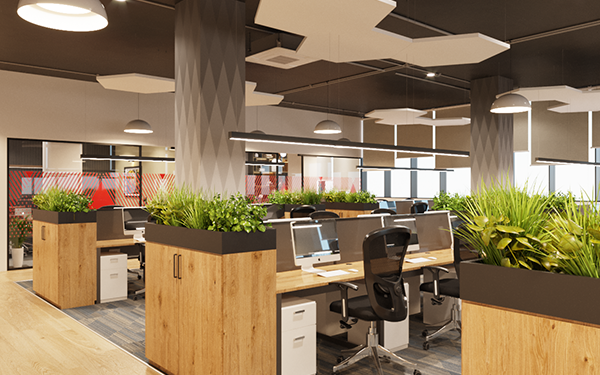
Adding greenery to modern office design is not only aesthetically pleasing but also beneficial for the health and well-being of employees. Here are some creative ways to incorporate greenery into modern office design:
Vertical gardens or living walls are a popular way to add greenery to modern office design. They not only create a stunning visual impact but also improve indoor air quality and reduce noise levels.
Adding indoor plants is another simple and effective way to incorporate greenery into office design. From small succulents to large potted plants, there are plenty of options to choose from depending on the available space and lighting conditions.
Biophilic design is an approach that incorporates nature into the design of indoor spaces. This can include the use of natural materials, such as wood or stone, as well as the integration of plants and natural lighting.
If your office has a flat roof, consider transforming it into a green roof. Not only does this provide additional space for employees to enjoy nature, but it also reduces energy costs by providing insulation and reducing the heat island effect.
Terrariums are small glass containers that can be filled with plants and mosses. They are a great way to add a touch of greenery to office desks and shelves.
By incorporating these creative ways to add greenery to modern office design, you can create a healthier and more inviting workspace for your employees.
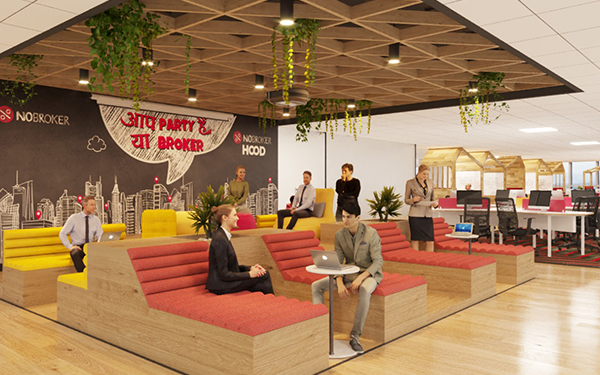
The layout of an office in a modern office design can have a significant impact on productivity. A well-designed office layout can help employees to work more efficiently, reduce distractions, and create a more positive and engaging work environment. Some of the key ways in which modern office design can impact productivity include:
A well-designed office layout can encourage collaboration and communication between employees, which can improve productivity by fostering teamwork and creativity.
A comfortable and ergonomic office layout can help to reduce stress and fatigue, which can lead to improved focus and productivity.
Proper lighting and noise control can reduce distractions and create a more conducive work environment, which can improve productivity.
An efficient space plan can help to optimize workflow and minimize wasted space, which can improve productivity and reduce costs.
Overall, it is important to carefully consider the layout of your office in a modern office design to ensure that it supports the productivity and well-being of your employees. By prioritizing collaboration, comfort, and efficiency in your modern office design, you can create a workspace that fosters productivity and success.
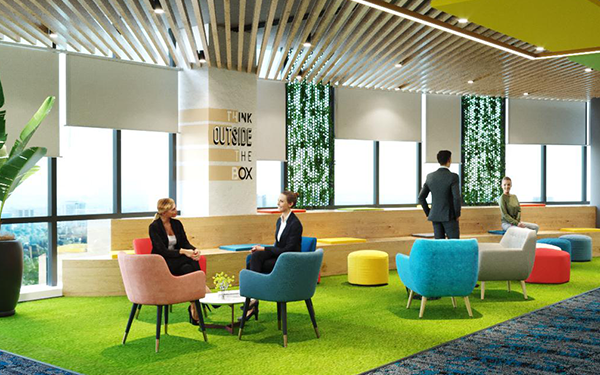
Optimizing space in modern office design is essential to create an efficient and productive workspace. Here are some ways to optimize space in modern office design:
Open floor plans allow for maximum flexibility in office layouts and make it easy to reconfigure the space as needed. By using open floor plans, you can maximize the use of the available space.
Multifunctional furniture pieces like desks that can convert to standing desks, or chairs that double as storage units can help save space and create a more functional office environment.
Modular walls can be easily moved and reconfigured to create a flexible workspace. These walls can also help create privacy and reduce noise levels.
Natural lighting can make a space feel more open and welcoming. It also helps to reduce energy costs by reducing the need for artificial lighting.
Collaboration spaces like conference rooms, breakout areas, or casual meeting spaces can help facilitate teamwork and collaboration while freeing up the rest of the office space for individual work.
By implementing these space-saving techniques in your modern office design, you can optimize your workspace to promote productivity, collaboration, and overall employee satisfaction.
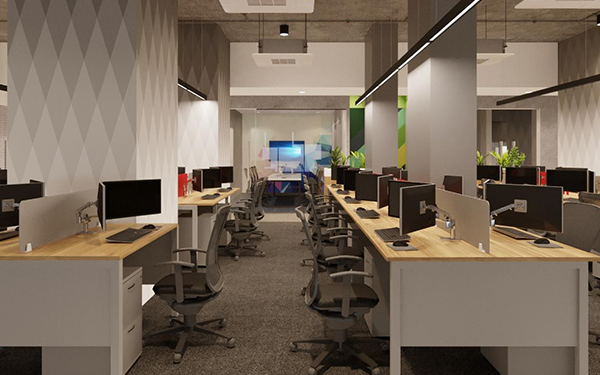
When it comes to managing sound in modern office design, there are several key strategies that can help to create a more acoustically comfortable workspace. These include:
One effective way to manage sound in the modern office is to incorporate sound-absorbing materials into the design. This can include materials such as acoustic ceiling tiles, sound-absorbing panels, and carpeting, which can help to reduce noise levels and create a more peaceful environment.
Another effective strategy is to create dedicated quiet spaces within the office where employees can work without distraction. This might include private offices, phone booths, or quiet rooms, which can be designed with soundproofing materials to help reduce noise levels.
The layout and furniture choices in the office can also impact sound levels. For example, open-plan offices with high ceilings and hard surfaces tend to be more noisy, whereas offices with lower ceilings and soft furnishings tend to be quieter. Choosing furniture that is designed to absorb sound, such as upholstered chairs and sofas, can also help to manage sound levels.
Finally, modern office design can also incorporate technology solutions to manage sound. This might include noise-cancelling headphones, sound masking systems, or video conferencing tools with built-in noise reduction features.
Overall, managing sound in modern office design is about creating a balanced and comfortable environment for employees to work in. By incorporating a range of strategies, it is possible to create a workspace that is both functional and acoustically comfortable.
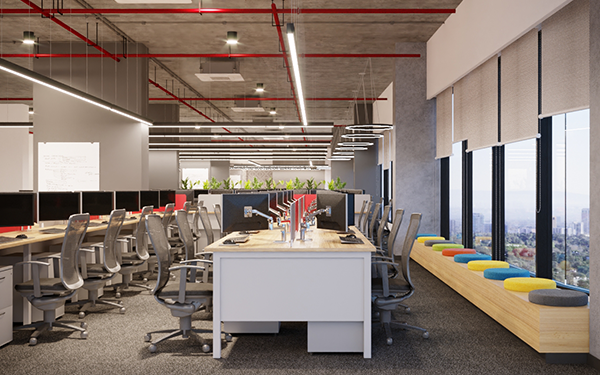
An open modern office design refers to a layout that features an open floor plan, shared workspaces, and minimal barriers or walls between employees. Here are some potential benefits of open modern office design:
Open modern office designs facilitate communication and collaboration among team members as they can easily interact and share ideas. This type of setup is called open modern office design and it promotes a culture of teamwork and encourages employees to work together, leading to better innovation and creativity.
Open modern office designs offer flexibility in terms of space utilization, allowing employees to move around and work in different areas depending on their needs. This type of environment in modern office designs can encourage creativity and prevent boredom or stagnation by providing workers with different spaces to work in throughout the day.
Open modern office designs tend to be more cost-effective than traditional office layouts since they require fewer walls, partitions, and doors. This can result in lower construction costs, lower energy costs, and lower furniture costs.
Open modern office designs can boost productivity since they provide a sense of belonging and create an atmosphere of transparency and accountability. The absence of barriers and walls ensures that employees feel more connected to their coworkers, leading to a higher level of engagement and motivation.
Open modern office designs can also lead to better employee wellness by creating a more comfortable and welcoming atmosphere. The natural light and fresh air from open windows can enhance employee mood, productivity, and mental wellbeing. Additionally, open office designs can encourage employees to move more, reducing the negative effects of a sedentary lifestyle.
It is important to note that while open modern office designs can offer many benefits, they may not be suitable for every workplace or employee. It is crucial to consider factors such as noise levels, privacy concerns, and individual working styles before implementing an open modern office design.
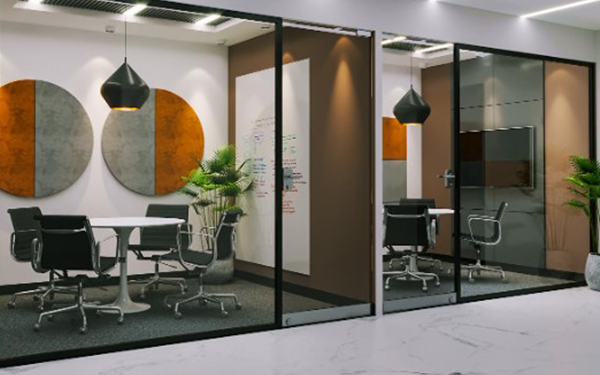
Maintaining privacy in an open modern office design can be challenging, but there are several ways to achieve it. Here are some tips to help you:
Adding partition walls between workstations can create a physical barrier and help reduce noise levels, while also providing employees with a sense of privacy.
Designate specific areas in the office where employees can have private conversations or work without distractions. For instance, you can create private phone booths or meeting rooms.
Encourage employees to use headphones to minimize noise and distractions, allowing them to focus on their work.
Implement a policy where confidential discussions are held in private spaces to ensure that sensitive information is not overheard.
Plants and decor can help create a physical barrier and provide a sense of privacy, while also adding aesthetic value to the modern office design.
By implementing these measures, you can help maintain privacy in an open modern office design and create a comfortable and productive work environment for your employees. Additionally, these measures can contribute to a positive work culture, which can lead to increased employee satisfaction and retention.
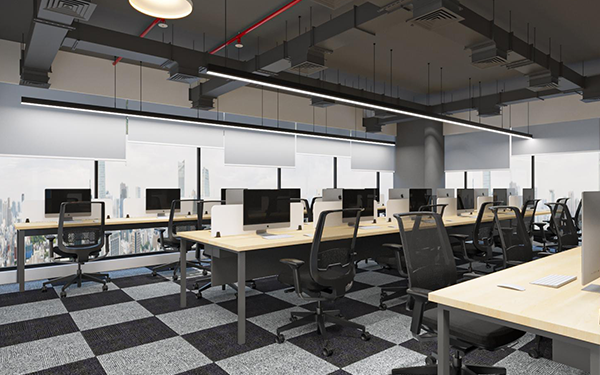
When it comes to modern office design, there are several common ergonomic considerations that can help improve employee comfort, health, and productivity. Some of these considerations include:
Office furniture such as desks, chairs, and monitors should be adjustable to accommodate different body sizes and postures.
Proper lighting can reduce eye strain and fatigue, and improve overall mood and productivity.
Temperature control is crucial to keep employees comfortable and productive. The ideal temperature is between 68-72 degrees Fahrenheit.
Acoustic design is an important aspect of modern office design, as excessive noise can cause distractions and reduce productivity.
Workstation layout should be designed to reduce unnecessary movement and promote good posture.
By incorporating these ergonomic considerations into modern office design, companies can improve the health and productivity of their employees, while reducing absenteeism and turnover rates.
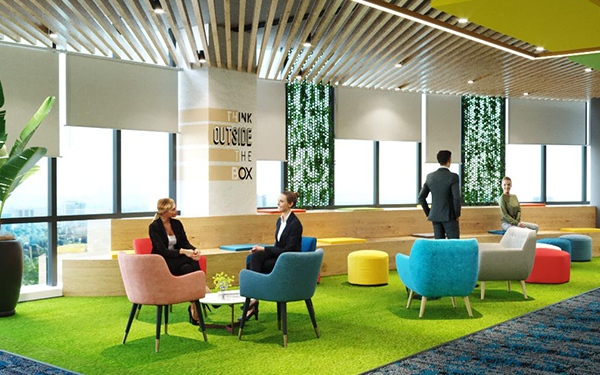
Modern office design can support collaboration in a number of ways. Here are a few examples:
Open spaces in modern office designs can foster collaboration by allowing employees to easily communicate with each other. For example, an open floor plan in modern office designs can create a more casual and collaborative atmosphere, making it easier for employees to share ideas and work together.
Creating areas specifically designed for collaboration in modern office designs can encourage teamwork. This can include shared workspaces, brainstorming rooms, or even outdoor areas in modern office designs
Modern offices should be equipped with the latest technology to support collaboration. This includes video conferencing systems, collaborative software, and other tools that enable employees to work together seamlessly, regardless of their location.
Modern offices should also be designed to accommodate different working styles and preferences. This can include flexible workstations in modern office designs that can be easily adjusted to meet the needs of different teams or individuals.
Creating a comfortable and inviting environment in modern office designs can also support collaboration. This can include amenities such as comfortable seating, natural lighting, and access to food and beverages.
Overall, modern office design should prioritize collaboration as a key factor in the workspace. By creating an environment that supports teamwork, communication, and creativity, organizations can encourage innovation and drive success.
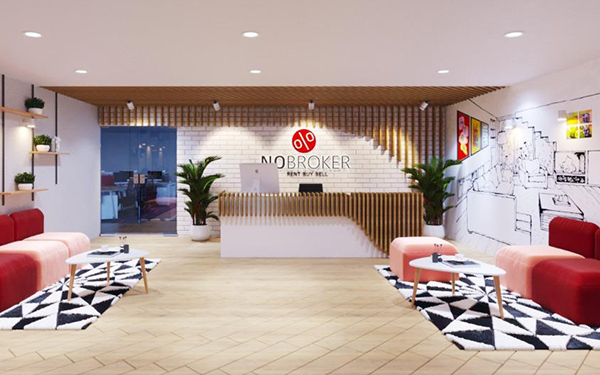
Creating a welcoming reception area in a modern office design can significantly impact the overall impression and experience of visitors. Here are some effective ways to achieve this goal:
Your reception area in a modern office design should be comfortable and inviting, so visitors feel welcome and at ease. Use comfortable seating options for your modern office design, add pillows or cushions, and ensure the temperature is pleasant.
Good lighting in a modern office design can make a big difference in the reception area's ambiance. Consider using natural light, installing overhead lighting, or using lamps to create a cozy atmosphere.
Plants can help purify the air and create a welcoming environment. Choose low-maintenance plants that require minimal watering and care in your modern office design.
Use your reception area to showcase your brand's personality and values. Display your logo, mission statement, or other branded items to create a cohesive and memorable experience for visitors in your modern office design.
Consider adding amenities like a coffee station or water cooler in your modern office design to make visitors feel comfortable and welcome. You could also offer reading material, free Wi-Fi, or charging stations to your modern office design.
By implementing these tips in a modern office design, you can create a welcoming reception area that makes a positive impression on visitors and reflects your brand's values and culture. Remember to keep the design modern and functional while creating a comfortable environment that encourages visitors to stay and relax.
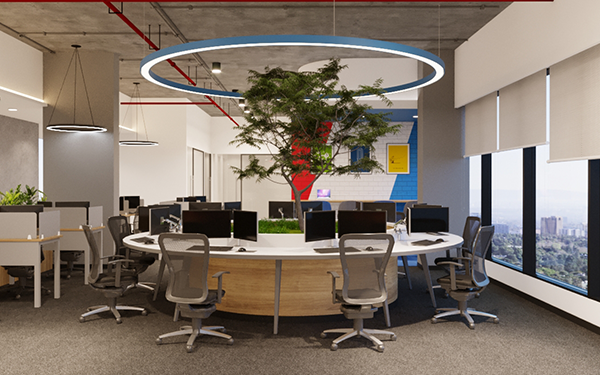
Modern Office design can have a significant impact on creativity and innovation in the workplace. Here are some ways that a well-designed office can encourage creativity:
A workspace that is comfortable, visually appealing, and provides a sense of inspiration can help employees feel more motivated and creative. Use natural light, colors, textures, and materials in modern office designs to create a welcoming and comfortable environment that fosters creativity.
Design your office space in a way that encourages collaboration and communication. Consider an open-plan layout with communal workspaces, breakout areas, and meeting rooms in modern office designs that allow people to interact and exchange ideas.
Employees may feel more creative when they are given the freedom to choose their workspace. Consider providing different areas for different types of work, such as quiet areas for focused work, collaborative spaces for group work, and casual areas for relaxation in modern office designs.
Give your employees access to the technology and resources they need to facilitate creativity. Consider providing high-speed internet, digital tools, and other resources that enable them to brainstorm, experiment, and explore new ideas.
A healthy and happy workforce is more likely to be creative and productive. Consider incorporating wellness features such as ergonomic furniture, standing desks, and plants in modern office designs to enhance employee well-being.
By incorporating these elements into your modern office design, you can create a workspace that fosters creativity, encourages innovation, and inspires your employees to reach their full potential.
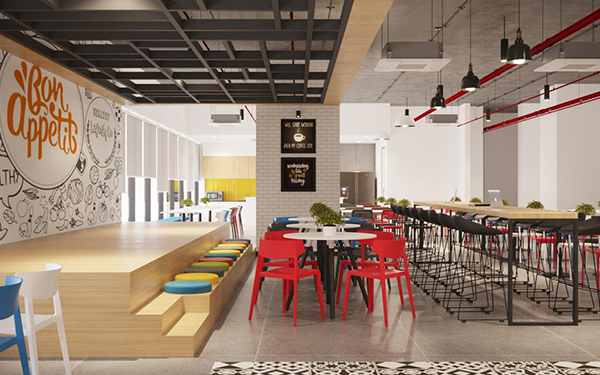
When it comes to modern office design, there are several popular flooring options that can enhance the aesthetic appeal of your workspace while also meeting practical needs. Some of the most commonly used flooring options to be used in modern office design include:
These are a popular choice for modern office designs as they provide comfort underfoot, reduce noise levels, and come in a wide range of colors and patterns.
These are durable, easy to clean, and offer a wide range of styles and colors for a modern office design that can mimic natural materials such as wood or stone.
This is a classic option for a modern office design that can add warmth and elegance to an office space. Hardwood is durable and can last for many years with proper maintenance.
These are durable, moisture-resistant, and easy to clean. They come in a wide range of colors, sizes, and patterns, allowing you to create a custom look for your modern office design.
This is a trendy option that can provide an industrial, minimalist look to your modern office design. Concrete is durable, easy to maintain, and can be stained or polished to achieve a variety of finishes.
When choosing a flooring option for your modern office, it's important to consider factors such as durability, ease of maintenance, and the overall aesthetic appeal in a modern office design.
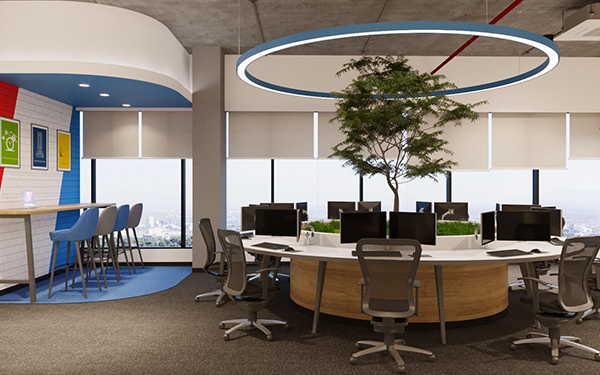
Modern office design can accommodate remote workers by providing flexible workspaces that support a hybrid work environment. This can include creating collaborative spaces in offices that allow remote workers to connect with in-office staff, as well as offering private areas for remote workers to focus and complete tasks.
Designing an office with a variety of technology tools, such as video conferencing and collaboration software, can also help remote workers feel connected and engaged with their colleagues, thus accommodating remote workers in modern office design.
Additionally, modern office designs prioritize natural light, comfortable seating, and ergonomic workstations which promotes wellness and productivity for all employees, regardless of whether they are working in-office or remotely.
Ultimately, the key to accommodating remote workers through modern office design is to create a workspace that supports a variety of work styles and provides access to the resources and tools needed to get the job done effectively, no matter where an employee is located.
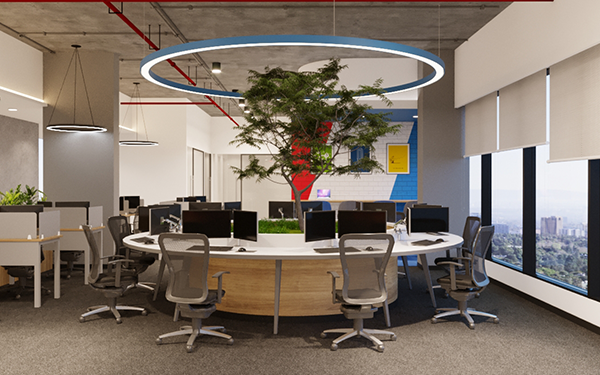
Updating a conventional office design to modern office design can be a great way to improve the productivity and morale of your team, but it can also be costly. However, there are several cost-effective ways to update a conventional office design to modern office design that can improve its aesthetics and functionality without breaking the bank.
One option is to rearrange the furniture and decorations within your office space to create a new layout. This can be a simple and inexpensive way to give your office a fresh new look and feel.
Another cost-effective way to update your conventional office design to modern office design is to add some new decorations, such as plants, artwork, or accent lighting. These can add color and personality to your space and create a more inviting atmosphere for your team.
You can also consider upgrading some of your office equipment or furniture with budget-friendly options. For example, you can opt for affordable ergonomic chairs or desks to improve the comfort and health of your team members.
Finally, consider using paint or wallpaper to update your office's walls. This can be a low-cost way to add a pop of color or pattern to your space and create a more lively and modern atmosphere.
Overall, there are many cost-effective ways to update a conventional office design to modern office design. By being creative and resourceful, you can create a fresh and inspiring workspace for your team without breaking the bank.
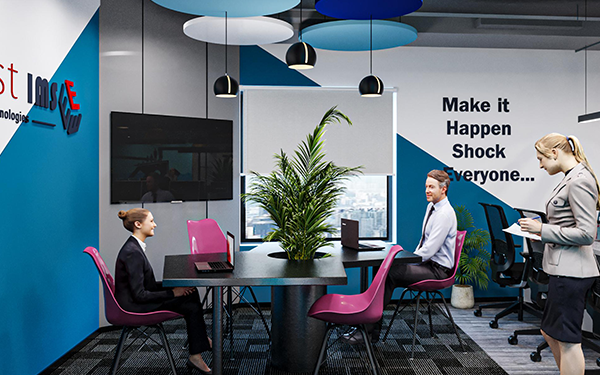
Incorporating color in modern office design can be an effective way to create a more engaging and productive work environment. Here are some innovative ways to use color in modern office design:
Choose a color scheme that helps to visually differentiate different areas of the office in the modern office design, such as workspaces, break rooms, and meeting rooms.
Use bright or bold colors in strategic areas of the office to draw attention and create focal points in the modern office design. This can be particularly effective in reception areas or other high-traffic areas.
Different colors can evoke different emotions in people, so choose colors that align with your brand's personality or the desired mood you want to create in your office and then include it in your modern office design.
Studies have shown that certain colors can improve productivity and focus, such as blues and greens. Consider using these colors in areas where employees need to concentrate or be creative.
Incorporate your brand's colors into your modern office design to create a cohesive look and feel that reflects your brand's identity.
Overall, using color in modern office design is a great way to create an engaging and productive work environment. By strategically using color to define spaces, create focal points, evoke emotions, improve productivity, and showcase your brand, you can create a visually appealing and functional office space & modern office design that employees will love.
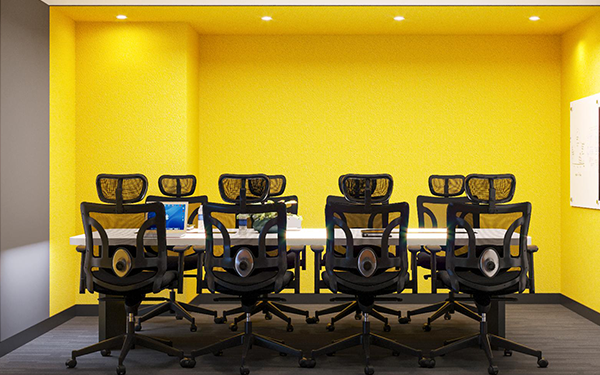
The design of meeting rooms in modern office designs can have a significant impact on productivity in the modern office. Here are some ways in which meeting room design can affect productivity:
The layout and configuration of a meeting room in modern office designs can have a significant impact on the productivity of the participants. The room in modern office designs should be designed in such a way that it allows for easy communication and collaboration among team members. For example, a circular table configuration can help facilitate better communication and collaboration than a rectangular or square one.
The comfort and ergonomics of the meeting room in modern office designs can also impact productivity. The chairs and tables should be designed to provide comfort to the participants, which will help them to focus on the meeting and not on their discomfort.
Lighting is an essential element in the design of meeting rooms. Poor lighting in modern office designs can cause eye strain and fatigue, leading to reduced productivity. Proper lighting in modern office designs can help create a comfortable and productive atmosphere.
Modern meeting rooms require the latest technology and audio/visual equipment to facilitate effective communication and collaboration. This includes video conferencing equipment, interactive whiteboards, projectors, and screens to be included in the modern office designs
The acoustics of the meeting room can impact productivity. The room should be designed to reduce noise and echo, which can be distracting and reduce concentration.
The color and design of the meeting room can also impact productivity. Colors like blue and green are known to promote calmness and concentration, while warm colors like red and orange can be distracting. The design should be simple, modern, and uncluttered, which will help participants to focus on the meeting.
In summary, the design of meeting rooms plays a critical role in improving productivity in the modern office. A well-designed meeting room in modern office designs can create a comfortable and productive atmosphere that promotes collaboration and effective communication among team members.
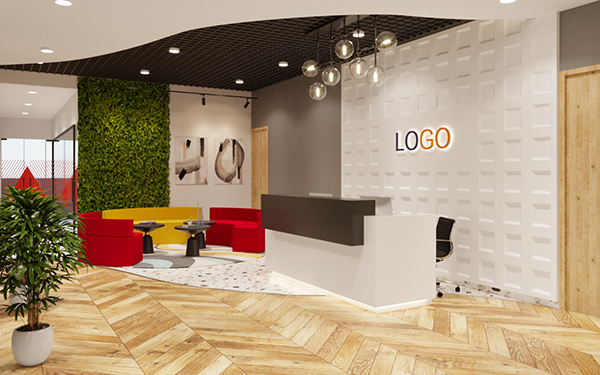
Incorporating branding into modern office design can have a significant impact on the overall brand image and perception of a company. Here are some effective ways to incorporate branding into modern office design:
Incorporating brand colors and logos into the design can help create a cohesive and memorable look. This can be done through accent walls, furniture, and accessories.
It's important to ensure that all design elements are consistent with the brand's visual identity. This includes typography, graphics, and other design elements.
Using branded signage throughout the office in the modern office design can help reinforce the brand and create a professional look. This includes signage for the reception area, conference rooms, and other areas of the office in the modern office design.
Use brand messaging in the modern office design to communicate the company's values and mission. This can be done through posters, wall art, and other decorative elements.
The overall atmosphere of the office should align with the company's brand values. For example, if the brand is focused on innovation and creativity, the modern office design should reflect that with open and collaborative spaces.
By incorporating these branding strategies into modern office design, companies can create a visually compelling and memorable workplace that reflects their brand identity and values.
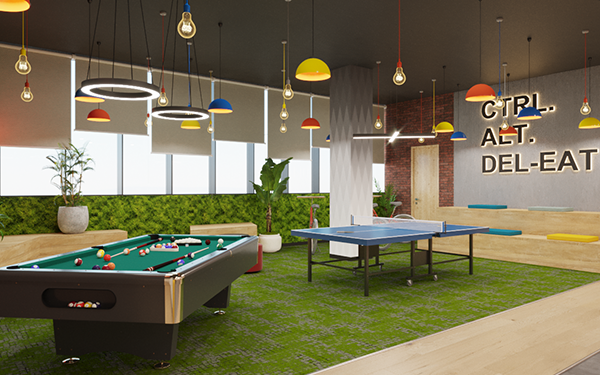
Modern office design can help reduce stress in the workplace in several ways. Firstly, incorporating natural elements such as plants and natural light in the modern office design can have a calming effect on employees and help to reduce anxiety levels. Additionally, creating spaces for relaxation and mindfulness, such as quiet areas or meditation rooms in the modern office design can provide employees with a break from the demands of work and help to promote mental well-being.
In terms of the layout, incorporating ergonomic furniture and adjustable workstations can help to reduce physical stress on employees, such as neck and back pain. It is also important to consider the acoustics of the space, as noise pollution can increase stress levels. By using sound-absorbing materials and designing spaces with noise in mind, employees can work in a more peaceful and productive environment.
Finally, incorporating technology such as temperature and lighting controls can help employees to feel more comfortable in the workplace and improve their overall well-being. By taking these steps, modern office design can help to reduce stress and create a positive work environment that promotes productivity, collaboration, and overall employee satisfaction.
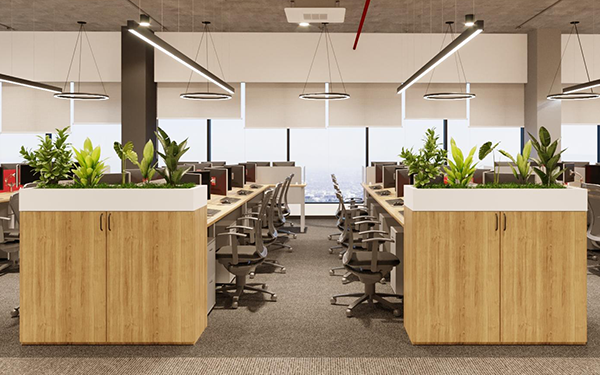
Natural light is an essential component of modern office design, as it can improve productivity, reduce energy costs, and enhance the overall workplace environment. To maximize natural light in an office space, there are several key strategies to consider in a modern office design.
First, consider the orientation and layout of the office space in a modern office design. Ideally, the office should be positioned to face south or southwest to maximize exposure to sunlight throughout the day. Additionally, open floor plans and glass walls can help distribute natural light more evenly throughout the space.
Second, select materials and finishes that reflect and amplify natural light. Light-colored walls, ceilings, and floors can help bounce light around the office, while mirrors and glossy surfaces can reflect light and make the space feel brighter in modern office design.
Third, incorporate window treatments that allow natural light to enter the space while still providing privacy and reducing glare. Options may include sheer curtains, blinds, or tinted glass.
Finally, consider adding greenery to the office space. Plants not only add aesthetic appeal but also can help filter the air and create a more pleasant and inviting work environment.
By implementing these strategies, modern office design can maximize natural light, improve employee well-being, and enhance the overall functionality and aesthetic appeal of the workspace.
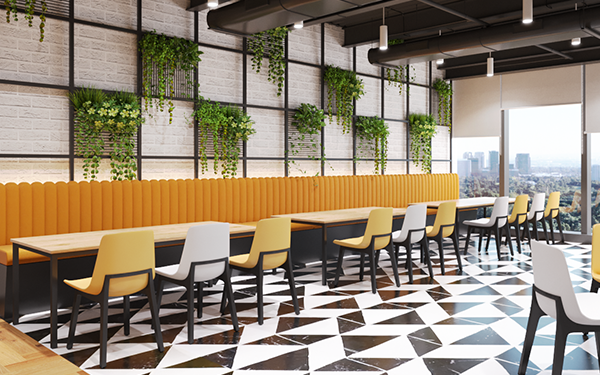
Incorporating sustainable materials into modern office design can not only enhance the aesthetic appeal of your workspace but also reduce your carbon footprint. Here are some ways to incorporate sustainable materials into modern office design:
Incorporate recycled materials such as recycled wood, glass, and plastic into your modern office design. These materials can help reduce waste and save energy, while still providing an aesthetically pleasing look.
Opt for eco-friendly furniture in modern office designs which is made from sustainable